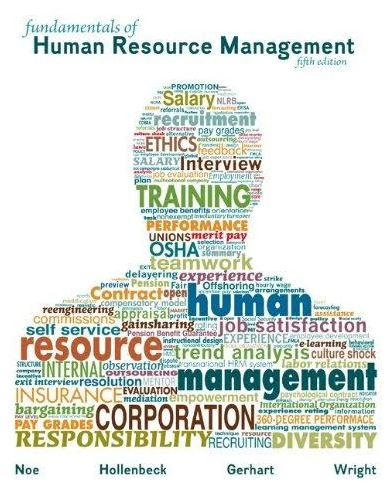
Fundamentals of Human Resource Management 5th Edition by Raymond Noe, John Hollenbeck, Barry Gerhart, Patrick Wright
Edition 5ISBN: 9780077515522
Fundamentals of Human Resource Management 5th Edition by Raymond Noe, John Hollenbeck, Barry Gerhart, Patrick Wright
Edition 5ISBN: 9780077515522 Exercise 6
ARE FORCED RANKINGS FAIR?
Emotions can run high when it comes to the performance management practice of using forced rankings to identify the top performers to retain and the bottom performers to let go. When Jack Welch was chief executive officer of General Electric, he introduced and later championed this method. At GE, managers were ranked according to their performance against goals and sorted into the top 20% (who were richly rewarded), the middle 70%, and the bottom 10% (who often were asked to leave). Today LendingTree follows a similar approach, ranking managers as 1s (the top 15%), 2s (the middle 75%), and 3s (the bottom 10%). The idea is that if the organization lays off the 3s, it can later replace them with people who have the potential to become 1s, improving the overall performance. American International Group (AIG) recently began ranking employees on a scale of 1 to 5, with the biggest bonuses awarded to the top categories and no bonuses to the worst performers.
Critics deride the method, which they call "rank and yank," as ruthless and even demotivating. In their view, organizations should hire and develop good talent, so if the organization is well run, it shouldn't have any underperformers. In addition, they say, the practice tempts managers to compete against one another and perhaps undermine one another when they should be cooperating to help the organization attain its goals. If the organization wants teamwork but being a team player means you help your colleague meet more goals than you did and earn a higher ranking, would you want to be a team player?
Jack Welch insists that forced ranking is actually the fairest approach if done well. Assuming that the organization has made its goals clear, every manager knows where he or she stands. If the organization dismisses someone for being one of the lowest performers, the decision is fairly based on performance rather than personalities or other irrelevant criteria. People who have underperformed their colleagues know it and respect the reasons for the decisions. In addition, forced rankings can correct for any unfairness that results from the common error of a manager tending to be harsh or lenient compared with peers evaluating other employees. Nevertheless, surveys suggest that many organizations are uncomfortable with the method. A study by the Institute for Corporate Productivity, for example, found that use of forced ranking fell from 42% in 2009 to just 14% in 2011.
How fair are forced rankings relative to the other methods of measuring performance described in this chapter?
Emotions can run high when it comes to the performance management practice of using forced rankings to identify the top performers to retain and the bottom performers to let go. When Jack Welch was chief executive officer of General Electric, he introduced and later championed this method. At GE, managers were ranked according to their performance against goals and sorted into the top 20% (who were richly rewarded), the middle 70%, and the bottom 10% (who often were asked to leave). Today LendingTree follows a similar approach, ranking managers as 1s (the top 15%), 2s (the middle 75%), and 3s (the bottom 10%). The idea is that if the organization lays off the 3s, it can later replace them with people who have the potential to become 1s, improving the overall performance. American International Group (AIG) recently began ranking employees on a scale of 1 to 5, with the biggest bonuses awarded to the top categories and no bonuses to the worst performers.
Critics deride the method, which they call "rank and yank," as ruthless and even demotivating. In their view, organizations should hire and develop good talent, so if the organization is well run, it shouldn't have any underperformers. In addition, they say, the practice tempts managers to compete against one another and perhaps undermine one another when they should be cooperating to help the organization attain its goals. If the organization wants teamwork but being a team player means you help your colleague meet more goals than you did and earn a higher ranking, would you want to be a team player?
Jack Welch insists that forced ranking is actually the fairest approach if done well. Assuming that the organization has made its goals clear, every manager knows where he or she stands. If the organization dismisses someone for being one of the lowest performers, the decision is fairly based on performance rather than personalities or other irrelevant criteria. People who have underperformed their colleagues know it and respect the reasons for the decisions. In addition, forced rankings can correct for any unfairness that results from the common error of a manager tending to be harsh or lenient compared with peers evaluating other employees. Nevertheless, surveys suggest that many organizations are uncomfortable with the method. A study by the Institute for Corporate Productivity, for example, found that use of forced ranking fell from 42% in 2009 to just 14% in 2011.
How fair are forced rankings relative to the other methods of measuring performance described in this chapter?
Explanation
Some other methods of measuring performa...
Fundamentals of Human Resource Management 5th Edition by Raymond Noe, John Hollenbeck, Barry Gerhart, Patrick Wright
Why don’t you like this exercise?
Other Minimum 8 character and maximum 255 character
Character 255


